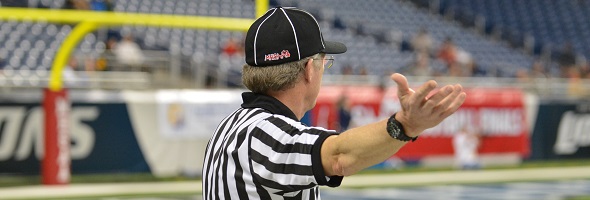
Be the Referee: Spearing
September 3, 2015
This week, MHSAA assistant director Mark Uyl explains the expanded definition of spearing added for football this season.
Be The Referee is a series of short messages designed to help educate people on the rules of different sports, to help them better understand the art of officiating, and to recruit officials.
Below is this week's segment - Spearing - Listen
One of the new changes to the high school football rules for this year is an expanded definition of spearing an opponent with the helmet. With all the attention on player safety and reducing the head-to-head collisions between players, this new definition of illegal helmet contact will better help officials, coaches, players and fans with what is illegal and must be penalized by rule.
Simply put, a spearing foul has taken place when any player hits an opponent with the crown, or top portion, of his helmet as the first point of contact. These fouls where contact has been initiated by a player first with the crown of the helmet must be called and enforced consistently throughout the season.
Past editions:
Aug. 27: Missed Field Goal - Listen

Be the Referee: Switching Sides
By
Sam Davis
MHSAA Director of Officials
September 6, 2022
Be The Referee is a series of short messages designed to help educate people on the rules of different sports, to help them better understand the art of officiating, and to recruit officials.
Below is this week's segment – Switching Sides - Listen
In volleyball, a rules modification that came about during COVID has been instated as a permanent change - with overwhelming support from coaches and officials.
Previously, teams would switch sides after each set, sometimes creating a traffic jam as players and coaches move benches from side to side. Unless there is a clear competitive advantage, there is no switching now. Coaches like having a dedicated home bench and the improved pace of the match.
Things that would necessitate teams switching would be less serving room on one end of the court, a window on one side with the sun shining in, or an overhead obstruction on one end.
It’s up to the official to determine if an advantage exists and if teams will switch at the end of each set – or stay on the same side for the entirety of the match.
Previous Editions:
Aug. 30: Play Clock - Listen
Aug. 23: Intentional Grounding Change - Listen

